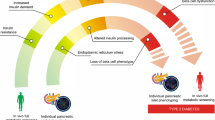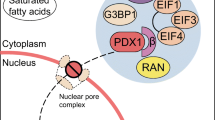Abstract
Aims/hypothesis
Regulation of insulin secretion along the secretory pathway is incompletely understood. We addressed the expression of SIL1, a nucleotide exchange factor for the endoplasmic reticulum (ER) chaperone glucose-regulated protein 78 kD (GRP78), in pancreatic beta cells and investigated whether or not SIL1 is involved in beta cell function.
Methods
SIL1 expression was analysed by immunoblotting and immunofluorescence. Metabolic and islet variables, including glucose tolerance, beta cell mass, insulin secretion, islet ultrastructure, insulin content and levels of ER stress marker proteins, were addressed in Sil1 knockout (Sil1 −/−) mice. Insulin, proinsulin and C-peptide release was addressed in Sil1 −/− islets, and SIL1 overexpression or knockdown was explored in MIN6 cells in vitro. Models of type 1 diabetes and insulin resistance were induced in Sil1 −/− mice by administration of streptozotocin (STZ) and a high-fat diet (HFD), respectively.
Results
We show that SIL1 is expressed in pancreatic beta cells and is required for islet insulin content, islet sizing, glucose tolerance and glucose-stimulated insulin secretion in vivo. Levels of pancreatic ER stress markers are increased in Sil1 −/− mice, and Sil1 −/− beta cell ER is ultrastructurally compromised. Isolated Sil1 −/− islets show lower proinsulin and insulin content and impaired glucose-stimulated insulin secretion. Modulation of SIL1 protein levels in MIN6 cells correlates with changes in insulin content and secreted insulin. Furthermore, Sil1 −/− mice are more susceptible to STZ-induced type 1 diabetes with increased apoptosis. Upon HFD feeding, Sil1 −/− mice show markedly lower insulin secretion and exacerbated glucose intolerance compared with control mice. Surprisingly, however, HFD-fed Sil1 −/− mice display pronounced islet hyperplasia with low amounts of insulin in total pancreas.
Conclusions/interpretation
These results reveal a novel role for the nucleotide exchange factor SIL1 in pancreatic beta cell function under physiological and disease conditions such as diabetes and the metabolic syndrome.







Similar content being viewed by others
Abbreviations
- BiP:
-
Binding immunoglobulin protein
- CHOP:
-
CCAAT-enhancer-binding protein homologous protein
- ER:
-
Endoplasmic reticulum
- GRP78:
-
Glucose-regulated protein 78 kDa
- HFD:
-
High-fat diet
- PERK:
-
Protein kinase RNA-like endoplasmic reticulum kinase
- shRNA:
-
Short hairpin RNA
- shSil1 :
-
Short hairpin Sil1
- STZ:
-
Streptozotocin
- TEM:
-
Transmission electron microscopy
- XBP-1:
-
X-box binding protein 1
References
Rorsman P, Braun M (2013) Regulation of insulin secretion in human pancreatic islets. Annu Rev Physiol 75:155–179
Weiss MA (2009) Proinsulin and the genetics of diabetes mellitus. J Biol Chem 284:19159–19163
Back SH, Kaufman RJ (2012) Endoplasmic reticulum stress and type 2 diabetes. Annu Rev Biochem 81:767–793
Lee AH, Heidtman K, Hotamisligil GS, Glimcher LH (2011) Dual and opposing roles of the unfolded protein response regulated by IRE1alpha and XBP1 in proinsulin processing and insulin secretion. Proc Natl Acad Sci U S A 108:8885–8890
Zhang P, McGrath B, Li S et al (2002) The PERK eukaryotic initiation factor 2 alpha kinase is required for the development of the skeletal system, postnatal growth, and the function and viability of the pancreas. Mol Cell Biol 22:3864–3874
Senee V, Vattem KM, Delepine M et al (2004) Wolcott-Rallison syndrome: clinical, genetic, and functional study of EIF2AK3 mutations and suggestion of genetic heterogeneity. Diabetes 53:1876–1883
Sha H, He Y, Yang L, Qi L (2011) Stressed out about obesity: IRE1alpha-XBP1 in metabolic disorders. Trends Endocrinol Metab 22:374–381
Zhang L, Lai E, Teodoro T, Volchuk A (2009) GRP78, but not protein-disulfide isomerase, partially reverses hyperglycemia-induced inhibition of insulin synthesis and secretion in pancreatic β-cells. J Biol Chem 284:5289–5298
Scheuner D, Vander Mierde D, Song B et al (2005) Control of mRNA translation preserves endoplasmic reticulum function in beta cells and maintains glucose homeostasis. Nat Med 11:757–764
Matlack KE, Misselwitz B, Plath K, Rapoport TA (1999) BiP acts as a molecular ratchet during posttranslational transport of prepro-alpha factor across the ER membrane. Cell 97:553–564
Hebert DN, Molinari M (2007) In and out of the ER: protein folding, quality control, degradation, and related human diseases. Physiol Rev 87:1377–1408
Chung KT, Shen Y, Hendershot LM (2002) BAP, a mammalian BiP-associated protein, is a nucleotide exchange factor that regulates the ATPase activity of BiP. J Biol Chem 277:47557–47563
Zhao L, Longo-Guess C, Harris BS, Lee JW, Ackerman SL (2005) Protein accumulation and neurodegeneration in the woozy mutant mouse is caused by disruption of SIL1, a cochaperone of BiP. Nat Genet 37:974–979
Senderek J, Krieger M, Stendel C et al (2005) Mutations in SIL1 cause Marinesco-Sjogren syndrome, a cerebellar ataxia with cataract and myopathy. Nat Genet 37:1312–1314
Anttonen AK, Mahjneh I, Hamalainen RH et al (2005) The gene disrupted in Marinesco-Sjogren syndrome encodes SIL1, an HSPA5 cochaperone. Nat Genet 37:1309–1311
Li DS, Yuan YH, Tu HJ, Liang QL, Dai LJ (2009) A protocol for islet isolation from mouse pancreas. Nat Protoc 4:1649–1652
Shum AM, Mahendradatta T, Taylor RJ et al (2012) Disruption of MEF2C signaling and loss of sarcomeric and mitochondrial integrity in cancer-induced skeletal muscle wasting. Aging 4:133–143
Ke YD, Delerue F, Gladbach A, Gotz J, Ittner LM (2009) Experimental diabetes mellitus exacerbates tau pathology in a transgenic mouse model of Alzheimer’s disease. PLoS One 4:e7917
Ittner A, Block H, Reichel CA et al (2012) Regulation of PTEN activity by p38delta-PKD1 signaling in neutrophils confers inflammatory responses in the lung. J Exp Med 209:2229–2246
van Eersel J, Ke YD, Liu X et al (2010) Sodium selenate mitigates tau pathology, neurodegeneration, and functional deficits in Alzheimer’s disease models. Proc Natl Acad Sci U S A 107:13888–13893
Miyazaki J, Araki K, Yamato E et al (1990) Establishment of a pancreatic beta cell line that retains glucose-inducible insulin secretion: special reference to expression of glucose transporter isoforms. Endocrinology 127:126–132
Ishihara H, Asano T, Tsukuda K et al (1993) Pancreatic beta cell line MIN6 exhibits characteristics of glucose metabolism and glucose-stimulated insulin secretion similar to those of normal islets. Diabetologia 36:1139–1145
Buettner R, Scholmerich J, Bollheimer LC (2007) High-fat diets: modeling the metabolic disorders of human obesity in rodents. Obesity (Silver Spring) 15:798–808
Ramnanan CJ, Edgerton DS, Kraft G, Cherrington AD (2011) Physiologic action of glucagon on liver glucose metabolism. Diabetes Obes Metab 13(Suppl 1):118–125
Cnop M, Welsh N, Jonas JC, Jorns A, Lenzen S, Eizirik DL (2005) Mechanisms of pancreatic beta-cell death in type 1 and type 2 diabetes: many differences, few similarities. Diabetes 54(Suppl 2):S97–S107
Anttonen AK, Siintola E, Tranebjaerg L et al (2008) Novel SIL1 mutations and exclusion of functional candidate genes in Marinesco-Sjogren syndrome. Eur J Hum Genet 16:961–969
Ravelli RB, Kalicharan RD, Avramut MC et al (2013) Destruction of tissue, cells and organelles in type 1 diabetic rats presented at macromolecular resolution. Sci Rep 3:1804
Gupta S, McGrath B, Cavener DR (2010) PERK (EIF2AK3) regulates proinsulin trafficking and quality control in the secretory pathway. Diabetes 59:1937–1947
Itoh N, Okamoto H (1980) Translational control of proinsulin synthesis by glucose. Nature 283:100–102
Jensen MV, Joseph JW, Ronnebaum SM et al (2008) Metabolic cycling in control of glucose-stimulated insulin secretion. Am J Physiol Endocrinol Metab 295:E1287–E1297
Wiederkehr A, Wollheim CB (2012) Mitochondrial signals drive insulin secretion in the pancreatic beta-cell. Mol Cell Endocrinol 353:128–137
Mayer M, Kies U, Kammermeier R, Buchner J (2000) BiP and PDI cooperate in the oxidative folding of antibodies in vitro. J Biol Chem 275:29421–29425
Yan M, Li J, Sha B (2011) Structural analysis of the Sil1-Bip complex reveals the mechanism for Sil1 to function as a nucleotide-exchange factor. Biochem J 438:447–455
Weitzmann A, Volkmer J, Zimmermann R (2006) The nucleotide exchange factor activity of Grp170 may explain the non-lethal phenotype of loss of Sil1 function in man and mouse. FEBS Lett 580:5237–5240
Tabas I, Ron D (2011) Integrating the mechanisms of apoptosis induced by endoplasmic reticulum stress. Nat Cell Biol 13:184–190
Terauchi Y, Takamoto I, Kubota N et al (2007) Glucokinase and IRS-2 are required for compensatory beta cell hyperplasia in response to high-fat diet-induced insulin resistance. J Clin Invest 117:246–257
Cozar-Castellano I, Fiaschi-Taesch N, Bigatel TA et al (2006) Molecular control of cell cycle progression in the pancreatic beta-cell. Endocr Rev 27:356–370
Okada T, Liew CW, Hu J et al (2007) Insulin receptors in beta-cells are critical for islet compensatory growth response to insulin resistance. Proc Natl Acad Sci U S A 104:8977–8982
Ahren J, Ahren B, Wierup N (2010) Increased beta-cell volume in mice fed a high-fat diet: a dynamic study over 12 months. Islets 2:353–356
Diaferia GR, Cirulli V, Biunno I (2013) SEL1L regulates adhesion, proliferation and secretion of insulin by affecting integrin signaling. PLoS One 8:e79458
Acknowledgements
The authors thank Dr J.-I. Miyazaki (Osaka University, Osaka, Japan) for providing the MIN6 cell line and S. Fraser (Electron Microscope Unit, University of New South Wales, Sydney, NSW, Australia) for technical assistance.
Duality of interest
The authors declare that there is no duality of interest associated with this manuscript.
Contribution statement
AI designed experiments, analysed the data and wrote the manuscript. JB, BC and JvE performed experiments, analysed the data and drafted parts of manuscript. PP and LMI designed study and experiments and wrote the manuscript. All authors approved the final version. AI is responsible for the integrity of the work as a whole.
Funding
The research was supported by funding from the National Health and Medical Research Council (NHMRC), the Australian Research Council (ARC) and the University of New South Wales. LMI is a NHMRC Senior Research Fellow.
Author information
Authors and Affiliations
Corresponding author
Electronic supplementary material
Below is the link to the electronic supplementary material.
ESM Methods
(PDF 58 kb)
Rights and permissions
About this article
Cite this article
Ittner, A.A., Bertz, J., Chan, T.Y.B. et al. The nucleotide exchange factor SIL1 is required for glucose-stimulated insulin secretion from mouse pancreatic beta cells in vivo. Diabetologia 57, 1410–1419 (2014). https://doi.org/10.1007/s00125-014-3230-z
Received:
Accepted:
Published:
Issue Date:
DOI: https://doi.org/10.1007/s00125-014-3230-z




